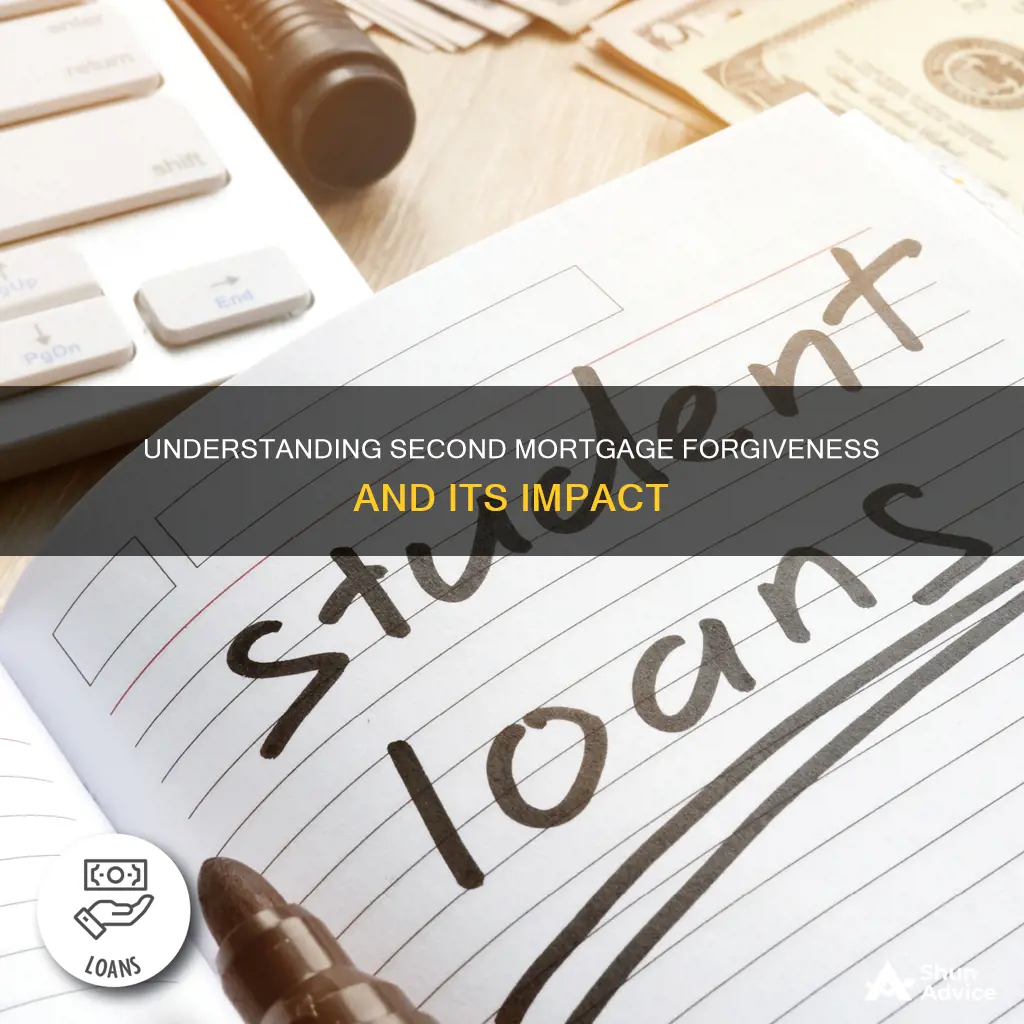
A second mortgage is a home loan taken out using your house as security. This is usually done simultaneously with the first mortgage but can also be done later, based on the equity in the home. If you fall behind on payments for your second mortgage, the lender may choose to foreclose, depending on the value of your home. In some cases, the lender may forgive the debt, but this is rare, and usually only occurs if the lender believes you will be unable to pay it back. Debt relief options are available, including a tax break through the Mortgage Forgiveness Debt Relief Act, which forgave taxes on discharged mortgage debt up to $2 million through 2020. This was extended through 2025 with a maximum of $750,000 by the Consolidated Appropriations Act, passed in December 2020.
How do you know if your 2nd mortgage was forgiven?
| Characteristics | Values |
|---|---|
| What is a second mortgage? | A home loan you take out using your house as security. |
| What is a "soft" second mortgage? | A loan with incredibly favorable terms for the borrower, including sub-market interest rates, lenient loan terms, and even full forgiveness in some instances. |
| What is a "silent" second mortgage? | A second mortgage that is used to secure down payment funds and isn't disclosed to the original mortgage lender prior to closing. |
| What happens if you don't pay your second mortgage? | The second mortgage lender may initiate foreclosure proceedings, depending on the home's value and other factors. |
| What is a "zombie" second mortgage? | A second mortgage that was thought to be forgiven or resolved but for which the lender later attempts to collect payment, often years later. |
| What is mortgage debt forgiveness? | A reduction in your home loan principal balance that involves negotiation and rewriting the original contract. |
| What are the tax implications of mortgage debt forgiveness? | The amount forgiven may need to be included in your gross income and taxed. |
| Are there any laws or acts that provide relief for mortgage debt? | The Mortgage Forgiveness Debt Relief Act of 2007 provided tax relief for certain cases of mortgage debt forgiveness, and this has been extended through 2025 with some changes. |
| How can I protect myself from illegal debt collection practices for a second mortgage? | Contact the Consumer Financial Protection Bureau (CFPB) to learn about your rights and take action to protect your home. |
What You'll Learn

Zombie second mortgages
Before the Great Recession in 2008, some mortgage lenders gave borrowers two mortgages for the same property instead of one. For example, a primary mortgage might cover 80% of the purchase price, and a second mortgage would cover the remaining 20%. The second mortgage was often used as a down payment, so the homebuyer wouldn't have to provide an actual cash down payment.
After the housing market crash in 2008, many of these second mortgages became uncollectible because homeowners could no longer afford the payments, and home prices had fallen so much that lenders wouldn't gain anything by foreclosing. As a result, some second mortgage holders wrote off these defaulted loans as uncollectible and stopped communicating with borrowers. In some cases, they sold the loans to debt buyers without informing the borrowers. Many homeowners believed that their second mortgages had been forgiven or resolved, especially if they had not received any notices or statements for years.
Now, as property values have increased and homeowners have paid down their primary mortgages, some are facing foreclosure notices and payment demands from companies claiming to own or have the right to collect on these long-dormant second mortgages. These once-forgotten debts have come back to life, hence the term "zombie" second mortgages.
If you find yourself facing a zombie second mortgage, it is essential to know your rights and the laws that protect consumers from unfair debt collection practices. You may have a defence if the creditor or collector engages in abusive, unfair, or deceptive collection practices, violates relevant laws and regulations, or fails to send periodic statements as required.
Creating a Mortgage Table: Excel Magic
You may want to see also

Foreclosure
The foreclosure process varies by state, but in general, lenders try to work with borrowers to get them caught up on payments and avoid foreclosure. The process generally begins when a borrower defaults or misses at least one mortgage payment. The lender then sends a missed-payment notice, indicating that the month's payment hasn't been received. If the borrower misses two payments, the lender sends a demand letter, which is more serious but may still involve the lender being willing to make arrangements for the borrower to catch up on missed payments. After 90 days of missed payments, the lender sends a notice of default. Once the loan is delinquent, the lender can proceed with foreclosure.
There are two main types of foreclosure: judicial foreclosure and non-judicial foreclosure. Judicial foreclosure, also known as foreclosure by judicial sale, involves the sale of the mortgaged property under the supervision of a court. The proceeds go first to satisfy the mortgage, then to other lienholders, and finally to the borrower if any proceeds are left. Judicial foreclosure is available in every US state and is required in some, including Florida, Illinois, and New York. The lender initiates the process by filing a lawsuit against the borrower, and a judicial decision is announced after the exchange of pleadings at a hearing.
Non-judicial foreclosure, also called foreclosure by power of sale, is authorized in many states if a power-of-sale clause is included in the mortgage or if a deed of trust with such a clause was used instead of an actual mortgage. This process involves the sale of the property by the mortgage holder without court supervision and is generally much faster and cheaper than judicial foreclosure. In the case of a deed of trust, the trustee can seize and sell the property without a court order. Non-judicial foreclosure is the norm in 28 states, including Arizona, California, Georgia, and Texas.
A foreclosure can have a significant impact on your credit report and score, and it stays on your record for seven years from the date of the first missed payment. It can hurt your ability to purchase or rent a home in the future, as many lenders will not consider applicants with a foreclosure on their credit report.
Regarding your second mortgage, it is important to note that defaulting on it can also lead to foreclosure. Whether the lender will foreclose depends mainly on the current value of your home. If your home is worth more than you owe on the first mortgage, the second mortgage lender is more likely to foreclose. During the foreclosure crisis, many lenders stopped trying to collect on defaulted second mortgages, and homeowners mistakenly believed their debt was forgiven. However, these "zombie" mortgages are now resurfacing, and lenders are attempting to collect on these old debts.
To know if your second mortgage was forgiven, you would need to review the terms of your loan agreement and consult with a legal or financial professional. It is important to understand your rights and obligations regarding any mortgage or loan agreement.
Cutting Mortgage Costs: Strategies to Halve Your Payments
You may want to see also

Tax implications
If you have a second mortgage on your home and fall behind on payments, the lender may or may not initiate foreclosure, depending on the value of your home. If you manage to settle the debt, be aware that settled or "cancelled" debt is usually considered income for tax purposes unless you qualify for an exception.
If you own a second home, you can significantly reduce the cost by claiming tax deductions for mortgage interest, property taxes, and rental expenses. You can also deduct interest on certain home equity loans. You might also be able to use a 1031 exchange to defer capital gains taxes. However, when you sell your second home, you must pay capital gains tax on the entire profit unless you make it your primary residence.
The Tax Cuts and Jobs Act (TCJA) changed how much you can save through mortgage interest deductions for both primary and secondary residences. If the second home is considered a personal residence, you must file Form 1040 or 1040-SR and itemize deductions on Schedule A to claim the mortgage interest deduction. Additionally, the mortgage must be a secured debt on a qualified home in which you have an ownership interest. In most cases, single filers and married couples filing jointly can deduct all their mortgage interest on up to $750,000 of mortgage debt.
For tax years before 2018, you can write off 100% of the interest on up to $1.1 million of debt secured by your first and second homes and used to acquire or improve the properties. This is a maximum of $1 million of mortgage debt plus a maximum of $100,000 of home equity debt. Beginning in 2018, the limit was reduced to $750,000 of debt secured by your first and second homes for binding contracts or loans originated after December 16, 2017. For loans prior to this date, the limit is $1 million ($1.1 million without the $100,000 home equity portion).
If you rent out your second home for 14 days or fewer during the year, the rental income is tax-free, and you can deduct mortgage interest and property taxes according to the rules for a second home. If you rent it out for more than 14 days, you must report your rental income, and expenses will need to be allocated between personal and rental use.
Becoming a Mortgage Originator: Steps to Success
You may want to see also

Soft second mortgages
A soft second mortgage is a loan with highly favourable terms for the borrower. Soft second mortgages are often offered through down payment assistance programs sponsored by local government agencies and the Department of Housing and Urban Development (HUD). These loans may carry a 0% interest rate and be forgiven over time. For example, a soft second loan of $20,000 may be forgiven at a rate of 20% per year, so that the loan is entirely forgiven within a five-year period.
If you have a second mortgage on your home and fall behind on payments, the second mortgage lender might foreclose, depending on the home's value. If you are unable to pay your second mortgage, you could ask your mortgage lender for a loan modification, which can involve lowering the interest rate, converting a variable interest rate to a fixed rate, or extending the loan term.
In some cases, homeowners may believe that their second mortgage debt has been forgiven or resolved, only to be pursued years later by debt collectors demanding payment of the outstanding balance, along with years of interest and fees. These are referred to as "zombie" second mortgages, and they particularly affect older borrowers, lower-income borrowers, and borrowers in communities of colour. The Consumer Financial Protection Bureau (CFPB) provides resources to help individuals understand their rights when dealing with debt collectors in such situations and take action to protect their homes.
Calculating Your Mortgage: $215,000 Commitment
You may want to see also

Loan modifications
A loan modification is a negotiation with your mortgage lender to create a new agreement that modifies the original terms of your mortgage. If you have a long-term inability to pay your mortgage, a loan modification could be an option if you wish to keep your home. A loan modification typically involves contacting the servicer for the lender (the company that sends you the mortgage statements each month) and negotiating to lower the interest rate on your mortgage, which will reduce the monthly payment. The actual amount of the loan does not change, and the balance of the unpaid mortgage is put at the end of the mortgage.
Some loan modification programs will allow borrowers to go through "re-amortization", which means artificially lengthening the repayment period for the loan, thereby reducing the monthly payment. If you have arrears on your mortgage, a loan modification could also lengthen the loan, adding the arrears and any past-due amounts over time. This can also reduce your mortgage payments. This is known as "re-capitalization".
To be eligible for a loan modification, you must do the following:
- State why you cannot make your current mortgage payment due to some financial hardship
- Provide all required documentation to the lender for evaluation, including a formal application, pay stubs, financial statements, proof of income, bank statements, and tax returns, as well as a hardship statement
- Complete a trial period to show that you can afford the new monthly payment
Once the loan modification is set, making timely payments will improve your credit since these payments will be reported to the credit bureaus. Eventually, your credit score will increase as each payment will build a solid credit history.
Now, to address your question about how to know if your second mortgage was forgiven. A second mortgage is an additional mortgage on one piece of property. It is considered "silent" if that second mortgage is used to secure down payment funds and isn't disclosed to the original mortgage lender prior to closing. Loans forgiven over time and loans with 0% interest are available through the down payment assistance programs. However, you won't know what you qualify for without doing some research. Contacting your local Department of Housing and Urban Development (HUD) office is a great first step.
During the foreclosure crisis, many lenders stopped trying to collect on defaulted second mortgages. Homeowners stopped receiving statements for these mortgages and mistakenly thought the debt was forgiven or resolved. Now, lenders are trying to collect on these old debts. If a lender seeks payment from you or threatens foreclosure on a zombie second mortgage, you might have a defence, such as abusive, unfair, or deceptive collection practices, which are illegal under federal or state laws.
Borrowing from Your Mortgage: What You Need to Know
You may want to see also
Frequently asked questions
A second mortgage is an additional mortgage on a property that already has a mortgage. It is considered "silent" if the second mortgage is used to secure the down payment funds and is not disclosed to the original mortgage lender.
If your second mortgage was forgiven, you would have received a notice from your lender or debt collector. You may also be able to check the status of your second mortgage by contacting the lender or checking your loan records.
If you fall behind on your second mortgage payments, the lender may initiate foreclosure proceedings, depending on the value of your home. You may also be sued personally for repayment of the loan if allowed by state law.
Mortgage forgiveness is a reduction in your home loan principal balance, which involves negotiating with your lender to rewrite your original contract. Mortgage forgiveness can occur through loan modification, short sale, foreclosure, or other debt relief options.







